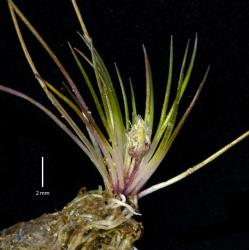Annual or perennial herbs, sub-aquatic or aquatic; small tufts from short erect rhizomes. Co-sexual, dioecious, or apomictic. Stem crystals absent. Leaves spiral, lamina filiform-linear, margins entire, 1‑veined. Peduncles scapose, axillary. Reproductive unit capitate, unisexual or bisexual (with carpels surrounding stamens), subtended by bracts in whorls; perianth absent. Stamens, with long, fine, cylindrical filaments, anther dehiscence latrorse; pollination syndrome anemophilous. Carpels, single stipitate, ascidiate; post-genital carpel closure incomplete; apex bearing 3–many apical multicellular, uniseriate stigmatic hairs (rarely absent), stigma absent; ovules 1 per carpel. Fruit an indehiscent achene or a capsule dehiscent via 3 ribs.
A monotypic family of one genus Trithuria. Traditionally treated in the Centrolepidaceae (Diels & Pritzel 1904; Edgar 1966; Edgar 1970), until Hamann (1976) published the family Hydatellaceae to accommodate Trithuria (Hooker 1860) and Hydatella (Diels & Pritzel 1904), outlining the significant differences from the centrolepids in embryology, seed anatomy, and flower and pollen morphology (Bortenschlager et al. 1966; Hamann 1975, 1976), but he was not able to establish its affinities "…the affinities of Hydatellaceae are still obscure" (Hamann 1976).
Hydatellaceae had continued to be classified as a monocot in the Poales until multi-genic phylogenetic analyses placed it in the Nymphaeales and sister to Cabombaceae and Nymphaeaceae (Saarela et al. 2007). Embryological evidence, seed morphology and sieve-element plastids support this placement (Hamann 1976; Rudall et al. 2008; Friedman 2008; Tratt et al. 2009).
Species of Hydatellaceae are minute, tufted herbs with linear leaves and inconspicuous flowering heads with two to several bracts surrounding the carpels and/or stamens. They differ significantly from other Nymphaeales, which are broad-leaved with showy petaloid flowers. Particularly unusual is the arrangement of the bisexual "reproductive units", where stamens are surrounded by carpels leading to early interpretations of the flowering head being a pseudanthium or inflorescence, an aggregation of unisexual perianthless flowers (Hooker 1860; Diels & Pritzel 1904; Edgar 1966; Hamann 1976). Also, they are described as having an "inside-out flower" and a "none-flower", and not able to be recognised as a typical angiosperm flower due to secondary loss or a pre-floral condition (Rudall et al. 2007, 2009). Despite recent morphological and anatomical studies, there is still uncertainty about the nature of the flowering head, and whether it is a pseudanthium, a flower, or a flower homologue (Sokoloff et al. 2010). Therefore the term ‘reproductive unit’ (Rudall et al. 2007; Sokoloff et al. 2008) is used here for the flowering head, in place of capitula, pseudanthium or inflorescence.
Until recently, two genera, Trithuria and Hydatella, were recognised for Hydatellaceae (Diels & Pritzel 1904; Edgar 1966; Edgar 1970; Cooke 1987). Diels & Pritzel (1904) originally distinguished Hydatella from Juncella F.Muell. ex Hieron. (= Trithuria) based on separate male and female ‘capitula’, stipitate flowers, longer and more numerous stigmatic hairs and a lesser number of involucral bracts (two rarely four). Based on Diels’ circumscription and the additional feature of indehiscent fruits, Cheeseman (1907) transferred the New Zealand species T. inconspicua to Hydatella, and this was followed by Edgar (1966) and Edgar (1970). Cooke (1981, 1983, 1987) recognised Trithuria and Hydatella based on the correlation of unisexual reproductive units and non-ribbed (indehiscent) fruits versus bisexual reproductive units and ribbed three-angled fruits (usually dehiscent). Sokoloff et al. (2008), with new insights and the discovery of additional species, demonstrated the non-correlation of these features and merged the two genera, with Trithuria Hook.f. having nomenclatural priority.
Biogeographical analyses date the stem lineage of Hydatellaceae to the early Cretaceous but the crown clade to the early Miocene, an indication that extant species mostly represent dispersal rather than vicariance (Iles et al. 2014). They infer an exception to the earliest split being vicariant and equating to tropical (northern Australia and India) versus subtropical/temperate lineages (South East Australia, Western Australia, New Zealand) and correlation with aridification of central Australia in the early Miocene. This may also correlate with differences in cotyledon morphology (Friedman et al. 2012; Iles et al. 2012; Sokoloff et al. 2008, 2013).
Minute tufts with non-petiolate linear leaves. The inconspicuous flowering heads have two to several bracts surrounding the carpels and/or stamens. A variable sexual system, either co-sexual, dioecious, or apomictic. Crystals are absent. Fruit an indehiscent achene (NZ) or a capsule dehiscent via three ribs.
Australia, India, New Zealand.
| Category | Number |
|---|---|
| Indigenous (Endemic) | 1 |
| Total | 1 |




